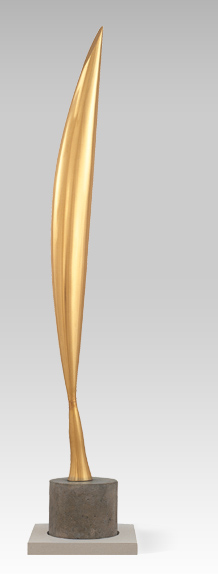|
|
More than anything, the Birds came to summarize Brancusi's distillation of form. The impetus for these works was mythological, and the earliest versions soon acquired the name Maiastra, from a Romanian magical creature akin to the firebird (this was also the subject of a contemporary ballet by Stravinsky). The open beak of the bronze Maiastra (1912)—the second in this sequence—may imply the bird's magical voice.
When Brancusi returned to the Birds after World War I, he shifted away from such mythical references. In the two versions carved in yellow and gray-blue marble, a tall, flame-like body dominates. His choice of colored marble lends a striking exoticism, while also being more difficult to carve as the veining is necessarily variable in texture. By the mid 1920s, Brancusi brought the theme to a new pitch of verticality in the Birds in Space, works that embody an idea of flight, and suggest liberation from material concerns. In 1927–8, one of the bronze Birds in Space unexpectedly became the subject of a notorious court case. Challenging the tax imposed by the American customs officials who classified it simply as metal raw material, Brancusi won legal recognition for abstract sculpture.
Contantin Brancusi, Bird in Space, 1932–1940. Polished brass, 59 3/4 inches high, including base. Peggy Guggenehim Collection. 76.2553 PG 51. © 2004 Artists Rights Society (ARS), New York/ADAGP, Paris.
|
|

